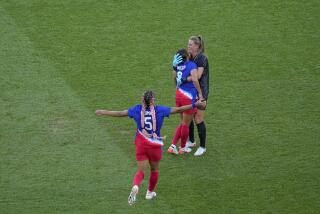A Tough Way to Finish for Akers
- Share via
The chant began as a low rumble, growing in strength, reverberating around the Rose Bowl.
“Akers . . . Akers . . . Akers.”
Michelle Akers had led the U.S. women in sliding tackles and leaping headers for much of the day, playing like a bull in a china shop, running until she collapsed.
Helped into the locker room at the start of overtime, her body in need of fluids, she had not been around to watch Brandi Chastain drive home the penalty kick that gave the U.S. team a Women’s World Cup championship victory over China.
But now, as the players took the victory stand to receive their medals, the crowd wanted Akers to come back. Her teammates understood why.
“She went flying in there with abandon,” goalkeeper Briana Scurry said. “She basically took over the midfield almost single-handedly.”
Said Chastain: “Toughest goddamn player I’ve ever played with.”
It was that kind of tournament for Akers, who scored the penalty-kick goal that cinched a semifinal victory over Brazil and is considered a leading candidate for the most valuable player award to be announced by FIFA.
By now, most people know the story of this 33-year-old veteran from Orlando, Fla. They know that she has continued to play world-class soccer while battling both age and Chronic Fatigue Syndrome. The highest-scoring player in the 1991 Women’s World Championship and an Olympic gold medal-winner, she has also adjusted to switching positions.
Moving back from center-forward, she now uses that 5-foot-10, 150-pound body to wreak havoc in the midfield.
“Her defensive pressure is much more of a key now,” Scurry said. “She’s played unbelievable defense this entire tournament.”
Not that Akers has left her offensive ways entirely behind. On Saturday, she unleashed the first two shots of the game, the second of which forced Chinese goalkeeper Gao Hong to make a jumping save in the 12th minute.
But more than offense, Akers provided emotion. On a day when both teams looked occasionally sluggish in the heat and humidity, she threw herself into the action.
One minute she was knocking a ball clear of the U.S. goal, flying headlong into the advertisement boards bordering the endline. The next minute, she was leaping for a crossing pass from Mia Hamm, colliding with Gao in mid-air.
When China had possession, she scrambled back to help contain the dangerous forward, Sun Wen. It seemed that every time a ball went in the air, Akers got to it.
“She controlled all the headers today,” Sun said. “She’s a very good player.”
The end for Akers came with yet another violent collision, this time in front of the American goal as players from both teams converged on the ball. While play swung back toward the opposite end of the field, Akers was left lying on the turf, cut down by exhaustion and dehydration.
“She hits the wall . . . you know she’s given everything she’s got,” midfielder Julie Foudy said. “You know when Michelle goes off, she can’t go anymore.”
Even so, Akers tried to stay close to the action, slumping on the bench for several minutes, a wet towel draped over her head, a team doctor with his arm around her shoulders. Finally, several assistants helped her to the locker room.
Her final numbers for the World Cup read two goals and an assist, ranking her among the two dozen scorers in the tournament. Her team says statistics don’t come close to describing her contribution.
“Leaving it all out on the field, fighting for her teammates,” Coach Tony DiCicco said. “Michelle Akers inspires me and everybody else on the U.S. team.”
Maybe that explains the chant during the medal presentation.
No surprise that the warrior answered one last call, wobbling back from the locker room, looking dazed but grinning. FIFA President Sepp Blatter greeted her with a kiss. The crowd roared.
Sure enough, Akers was still on her feet.
More to Read
Go beyond the scoreboard
Get the latest on L.A.'s teams in the daily Sports Report newsletter.
You may occasionally receive promotional content from the Los Angeles Times.







